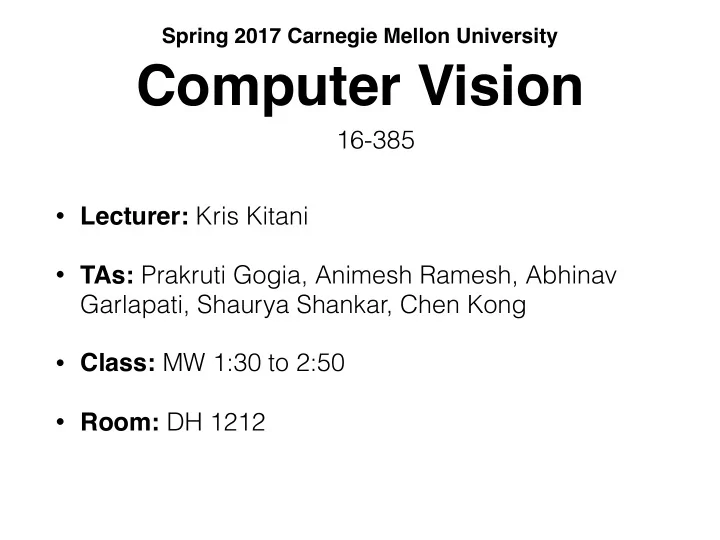

Spring 2017 Carnegie Mellon University Computer Vision 16-385 • Lecturer: Kris Kitani • TAs: Prakruti Gogia, Animesh Ramesh, Abhinav Garlapati, Shaurya Shankar, Chen Kong • Class: MW 1:30 to 2:50 • Room: DH 1212
today • staff introduction • what is computer vision? • modern applications of computer vision • administrative stuff ( ← important)
Prakruti Catherine Gogia Masters in Computer Vision pgogia@andrew.cmu.edu Research interests: • Semantic segmentation • Building creative tools using computer vision • Medical Image Analysis Office hours: Mondays 6-7pm, EDSH 200
Projects AR for Surgical Planning Snaps that chat! - Animating static images
Animesh ¡Ramesh -‑ 1 st ¡Year ¡Master’s ¡in ¡Computer ¡Vision, ¡CMU ¡(2016 ¡-‑ ¡17) ¡ -‑ MSRIT ¡(CS), ¡Bangalore ¡(2012 ¡-‑ ¡16) ¡ -‑ NUS ¡Research ¡Intern ¡(2015) Research ¡Interests: Autonomous ¡navigation Deep ¡Learning Office ¡Hours ¡ Machine ¡Learning Semantic ¡segmentation Wednesdays ¡ 4.30-‑5.30pm ¡ Object ¡Recognition Face ¡Recognition Smith ¡Hall ¡(EDSH) ¡200 ¡
Experience : • Integrated ¡autonomous ¡ • Developed ¡a ¡computer ¡vision ¡ navigation ¡to ¡a ¡Robotic ¡Water ¡ system ¡to ¡train ¡medical ¡ sensor ¡in ¡Singapore. students ¡for ¡surgeries. ¡
Abhinav Garlapati Masters in Computer Vision agarlapa@andrew.cmu.edu Research Interests: • Image and Video Understanding • Image classification • Activity Recognition Office Hours: Tuesdays 5:00pm-6:00pm EDSH 200
Chen Kong Third year PhD student Advisor: Simon Lucey chenk@cs.cmu.edu Research Interest: Non-rigid structure from motion (Group) sparse dictionary learning Compressive sensing Shape estimation from a single image Office hours: Friday 3-4pm, EDSH 210
Prior-less Compressible Structure from Motion • We demonstrated that a compressible 3D structure under weak perspective projection is 2 × 3 block-compressible. • If a 2 × 3 unique block sparse dictionary learning factorization can be obtained (of the 2D projections), we showed that the compressible 3D structure and camera motion can be recovered solely by the assumption of compressibility. • The dictionary mutual coherence implies the reconstructibility of the projected 3D structures. C. Kong and S. Lucey. Prior-less compressible structure from motion. Computer Vision and Pattern Recognition (CVPR) , 2016.
Structure from Object Category (a) Structure from Category • We introduced the concept of Structure from Category to reconstruct 3D shapes of generic object categories from a sequence of images. • Unlike most existing NRS f M methods, our approach requires no additional constraint on the shape or camera motion. Instead, all shapes and camera motion parameters (including shape (b) Structure from Motion bases) are jointly estimated through an t 1 t 2 t 3 t 4 t 5 · · · augmented sparse shape-space model. · · · • Our framework can be applied for large scale 3D reconstruction. C. Kong, R. Zhu, H. Kiani, and S. Lucey. Structure from category: a generic and prior-less approach. International Conference on 3D Vision (3DV) , 2016.
Dense 3D Reconstruction from a Single Image Input image LR SF LR SF Ground truth Volume • We proposed a novel graph embedding demonstrating that a deformable, dense 3D model can be inferred only from local dense correspondence, eschewing the need for global correspondence. • We proposed a two-step coarse-to-fine strategy using 2D landmarks and silhouette to reconstruct a deformable dense model from a single image. • Impressive results were shown on both synthetic and real-world natural images
Kumar ¡ Shaurya ¡ Shankar 3 rd ¡Year ¡PhD ¡Student ¡ kumarsha@cs.cmu.edu ¡ Office ¡Hours: ¡Thurs ¡12-‑1 ¡PM ¡NSH ¡2201
Flying ¡Through ¡The ¡Forests ¡of ¡Endor https://www.youtube.com/watch?v=hNsP6-‑K3Hn4A 13
Odometry ¡In ¡The ¡Real ¡World Conventional ¡digital ¡cameras ¡have ¡limited ¡dynamic ¡range https://www.youtube.com/watch?v=rvp17MZdbis 14
Conventional ¡6DoF ¡LK ¡Tracking What ¡parameterized ¡warp ¡best ¡minimizes ¡a ¡measure ¡ of ¡dissimilarity ¡between ¡a ¡reference ¡image ¡and ¡a ¡ candidate ¡image? Brightness ¡Constancy ¡ Assumption! This ¡is ¡fundamentally ¡violated ¡in ¡dynamic ¡conditions! 15
Mutual ¡Information ¡for ¡Registration • Images ¡are ¡a ¡joint ¡distribution ¡of ¡spatial ¡locations ¡and ¡intensity ¡ • Mutual ¡Information ¡is ¡an ¡established ¡measure ¡of ¡divergence ¡for ¡ distributions ¡ • Focus ¡on ¡ relative ¡ comparisons ¡as ¡opposed ¡to ¡absolute ¡measures 16
Comparison ¡under ¡Dynamic ¡Lighting Varying ¡Global ¡Illumination Three ¡orders ¡of ¡magnitude ¡smaller ¡per ¡frame ¡mean ¡error! ¡(10 -‑3 ¡vs ¡10 0 ¡m) Varying ¡Local ¡Illumination Related ¡Publication: ¡ K. ¡S. ¡Shankar ¡and ¡N. ¡Michael, ¡“Robust ¡Direct ¡Visual ¡Odometry ¡using ¡Mutual ¡Information”, ¡International ¡Symposium ¡on ¡ Safety, ¡Security ¡and ¡Rescue ¡Robotics ¡[Best ¡Student ¡Paper ¡Award]
University of Southern California (1995-1999) Kris Kitani KLA-Tencor Japan (2000-2003) University of Tokyo (2003-2008) University of Electro-Communications (2008-2011) University of California, San Diego (2010) Carnegie Mellon University (2011-present)
Activity Forecasting
Given an occluded interaction video extrapolate the missing image sequence
NavCog
Recommend
More recommend